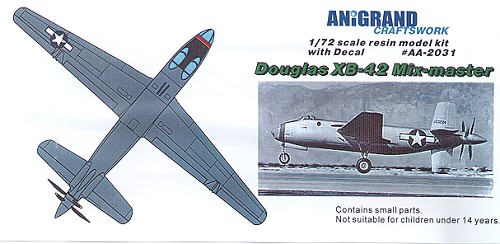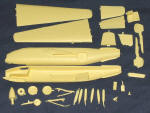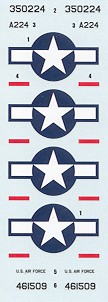
| KIT: | Anigrand Craftworks 1/72 XB-42 'Mixmaster' |
| KIT #: | AA-2031 |
| PRICE: | $54.00 from Nostalgic Plastic |
| DECALS: | One option |
| REVIEWER: | Scott Van Aken |
| NOTES: | Short Run Resin with vacuformed clear parts |

| HISTORY |
Douglas was generally an innovative company. Thanks to having solid designers, most of the aircraft that the built were successful, and so would have this Douglas initiated high speed bomber had not the turbine reared its ugly head. Despite having spectacular performance, its piston-engine power plant was enough to keep it from production.
Design work started in 1943 and the design was to have a top speed of 400 mph, a range of 2,000 miles and be able to haul 2,000 pounds of ordnance that distance. The thought was that burying the engines in the fuselage would allow a clean wing and the reduced drag would be enough to provide the performance needed. This did mean a pusher set-up as the nose would be needed for the crew.
The resulting aircraft first flew in May 1944, a year after the design had been approved. Other then the unusual engine placement, two 1,325 hp Allison V-1710-125 buried in the center fuselage, the aircraft also had a rear facing defensive armament of four .50 caliber machine guns in remote control barbettes just inboard of the ailerons on the trailing edge of the wing. Even with this defensive armament and rather large size, it was as fast as the Mosquito, had a longer range and was able to carry twice the ordnance.
Development of the prototype went very smoothly with the only real problems being poor visibility through the bubble canopies, a tendency to yaw and some minor cooling problems with the engines. Solutions were found quickly (the bubby canopies to be replaced by a standard bomber cockpit), and in December 1945, the aircraft flew from California to Washington DC in an average of 433 mph.
The end of the war and the desire for the USAAF to wait for improvements in turbojet technology to provide an even faster aircraft, spelled the doom of the project. The loss of one of the two prototypes (this one modified with a production standard canopy) didn't help. The second airframe had two turbojets incorporated under the wings for additional boost, but that was not enough to save the aircraft. This XB-42A was tested but struck off charge in mid-1949. It is now part of the Smithsonian collection.
| THE KIT |
 As
with all Anigrand kits, this one comes in an end-opening box that is quite
sturdy. Inside is the usual clear plastic bag that is compartmentalized to
hold the various bits. This helps keep the big pieces from smacking into
the finer ones and breaking them into bits. An instruction sheet and decal
sheet completes the package.
As
with all Anigrand kits, this one comes in an end-opening box that is quite
sturdy. Inside is the usual clear plastic bag that is compartmentalized to
hold the various bits. This helps keep the big pieces from smacking into
the finer ones and breaking them into bits. An instruction sheet and decal
sheet completes the package.
The molding on this kit is very much like previous Anigrand kits. It is basically like a standard short run styrene kit, but in resin. As a result of the low-tech molding process, the quality of the parts can vary considerably from one kit to another. My example was a huge improvement over the XFV-12 that I built recently. I found very little in the way of molding glitches. There were a few air bubbles near the thin parts of the stabs and fins. I also had a slightly short shot section under one of the wings near the gun barbettes, but it, as well as most of the air bubbles, will be easy to fix. Those that will be difficult are the air bubbles on the seat and the ones on the inside of the gear door where they straddle detail.
You do get a pretty nicely done
interior with a floor, a couple of seats and a control wheel. No instrument
panel, as usual, so it is off to the spares bin to try to find something to
fit in there. Not that it is really a problem as Anigrand's vac bits, while
OK, are not the clearest in the industry. Once again, you only get one set
of clear parts. However, according to their web site, you can buy an extra
set if you wish. Now I think they should include the second set and kick up
the price by the buck or two
they want for the second set. But you have heard this before! The only
other concern I found was that the mold for the main gear/wheel was
misaligned.
buck or two
they want for the second set. But you have heard this before! The only
other concern I found was that the mold for the main gear/wheel was
misaligned.
Other than that, the kit has very nice detailing with engraved detail that is just right for the scale. There is wheel well detail in this one, something that was missing from some previous kits. There are also keyways for the wing/fuselage join so no worries about butt joining the rather large wings. These wings are also nice and straight, as are the empennage pieces. The rear prop assembly is in two major pieces and seems as if it could easily be made to rotate. Though not stated in the instructions, the pitch of each set of blades was different to negate torque effects. If you look carefully as the exploded diagram you can make out which set rotates in which direction.
Standard for Anigrand kits, there is a single sheet with a color/decal placement diagram on one side, and a history, parts list, and exploded diagram on the other. The color diagram indicates that the interior and wheel wells were Interior Green. I should also mention that No nose weight info is give, but I'd try to put in as much as I could. This may cause the nose gear to warp after time, but otherwise, you'll have a tail-sitter for sure. The decal sheet is basically insignia and serial numbers. Both aircraft were in bare metal with red bands around the nose just behind the forward glazing. Concerning gear doors, the reference has photos of this aircraft with the large rear main gear doors open and closed while on the ground, so your choice.
| CONCLUSIONS |
Though not specifically marked as for experienced modelers only, this may well fit into the easy end of that category. If you have some experience working with resin and are not afraid to use those modeling skills, then this is a kit with which you will have no real trouble. In fact, due to its rather basic design, it may well be a good one for your first full resin plane kit!
February 2005
Thank to Nostalgic Plastic for the review sample. If you want one of these, get it soon as they sell out quickly.
| REFERENCES |
McDonnell Douglas Aircraft since 1920, vol 1, by Rene J. Fancillon, 1988.
If you would like your product reviewed fairly and quickly by a site that has nearly 300,000 visitors a month, please contact me or see other details in the Note to Contributors.